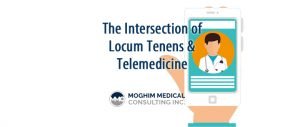 One of the most exciting developments in modern healthcare is telemedicine which enables providers to effectively engage and monitor patients through telephone and video conferencing. Telemedicine promises to revolutionize much of the healthcare industry in the coming years, but could be especially important for specialists in the locum tenens field.
One of the most exciting developments in modern healthcare is telemedicine which enables providers to effectively engage and monitor patients through telephone and video conferencing. Telemedicine promises to revolutionize much of the healthcare industry in the coming years, but could be especially important for specialists in the locum tenens field.
A burgeoning field that is quickly penetrating much of the healthcare sector, telehealth is rapidly becoming a fixture in physician-patient interactions. Major organizations like Kaiser Permanente now visit more patients via telehealth platforms than in-office visits. According to the American Telemedicine Association, telehealth is expected to grow at an annual rate of 27.5 percent and reach a market value of $9.35 billion by 2021.
The Physician Shortage
This important technology is maturing at a critical point in modern healthcare. There is an ongoing shortage of physicians in the United States that is rapidly increasing each year. Presently, there are 2.56 physicians per 1,000 residents, putting the U.S. 24th among the top 28 developed nations. The Association of American Medical Colleges predicts that there will be a shortage between 46,000 and 90,400 doctors by 2025.
This shortage is particularly severe in rural areas. The federal government has designated 6,000 jurisdictions as physician shortage areas. With almost one fifth of the nation residing in underserved areas, where there is an average of 39 primary care physicians and only 30 physician specialists per 100,000 residents, this physician shortage is reaching crisis proportions in many areas of the nation.
Rural Areas
In light of the growing demand for medical providers, especially in rural regions, the advantages of remote medicine burgeon in importance. Rural residents often lack ready access to healthcare due to physical distance, limited transportation options or socioeconomic barriers.
This is further compounded by the disproportionate need for medical care. Rural residents are 22 percent more likely to encounter injury-related death, and there is a higher occurrence of chronic diseases like heart disease or diabetes. Mental illness is also more likely to escape diagnosis among rural populations.
Locum Tenens and Telemedicine
Telemedicine in conjunction with locum tenens medical professionals may be the solution to this brewing crisis. More physicians are using these new technologies to assist local advanced practitioners on the scene in more complex cases like anaphylactic reactions, myocardial infarctions, or strokes.
Remote behavioral health professionals have proven enormously valuable in distributing care to mentally ill and substance abuse patients living in rural areas. Telemedicine sessions that occur in the home or discreet communication facilities can help overcome one of the biggest barriers to accessing behavioral healthcare—the stigma of being mentally ill.
This has contributed to a surge in demand for mental health telemedicine providers. Between 2004 and 2014, the number of rural mental health telemedicine visits rose from 2,365 to almost 87,000, an annual average growth of 45 percent.
Locum tenens professionals play a strong role in the success of telemedicine. Not only can their broad expertise play a critical role in diagnosis and urgent care, but the use of remote communication enables providers a relatively quick and inexpensive platform for monitoring patient progress throughout the recuperation. Telemedicine has proven to be a valuable time-saving tool that gives physicians and healthcare organizations the ability to see and treat more patients.
Article written by:
Dr. Robert Moghim, CEO Moghim Medical Consulting Inc.
